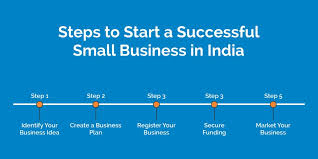India is a land of contrasts. It is home to one of the fastest-growing economies in the world, with millions of small businesses forming its backbone. At the same time, countless entrepreneurs struggle to survive due to poor planning, lack of awareness, and unpreparedness for challenges. The story of India’s entrepreneurial landscape can be described as “Big Country, Little Business”—a vast market brimming with opportunities, but where many small businesses fail to scale.
This guide offers insights into how to start a small business in India, taking inspiration from the lessons of this “big country, little business” paradox. Whether you are a first-time entrepreneur, an experienced professional transitioning into business, or a dreamer with a great idea, these steps will help you navigate the process of starting a business successfully.
1. Understanding the Indian Market
The first lesson of “Big Country, Little Business” is that India is huge, but fragmented. Consumer behaviors, preferences, and purchasing power differ significantly across regions. A product that sells in Mumbai may not resonate in Patna, and a service popular in Bangalore may fail in Jaipur.
Key Takeaway:
Before setting up a new business, conduct thorough market research. Understand your target customer, their pain points, and their willingness to pay. Use surveys, interviews, and competitor analysis to ensure that your idea has real demand.
2. Choosing the Right Business Idea
Many entrepreneurs fail because they chase trends without evaluating sustainability. The best way to start a small business is to align your idea with three factors:
- Market demand – Does your product or service solve a real problem?
- Personal skills and interests – Do you have the expertise or passion for this idea?
- Scalability – Can the business grow beyond its initial stage?
For example, food delivery apps thrived because they solved a widespread problem (convenience), aligned with technology trends, and were scalable across cities.
Key Takeaway:
Pick a business idea that solves a genuine need and has long-term potential, not just a short-lived trend.
3. Legal and Structural Setup
One of the most neglected aspects of the process of starting a business in India is legal compliance. Many small entrepreneurs skip proper registration, licenses, and tax filings, which later becomes a costly mistake.
Steps for business setup in India:
- Choose the right structure: sole proprietorship, partnership, LLP, or private limited company.
- Register your business with the Ministry of Corporate Affairs (MCA) or local authorities.
- Get necessary licenses: GST registration, Shops and Establishments Act license, or industry-specific permits.
- Protect your intellectual property by registering trademarks or copyrights if applicable.
Key Takeaway:
Compliance may seem tedious, but it builds credibility and protects your business in the long run.
4. Financial Planning and Funding
A recurring theme in the story of small businesses in India is underestimating costs. Many entrepreneurs burn out because they run out of funds or fail to manage cash flow effectively.
Best Practices:
- Prepare a realistic budget, factoring in rent, utilities, salaries, and marketing.
- Separate personal and business finances.
- Explore funding options like savings, family and friends, loans, or government schemes for MSMEs.
- Keep a 6–12 month emergency reserve.
Key Takeaway:
Strong financial planning is the backbone of sustainability. The best way to start a business is by ensuring you can survive the tough early months.
5. Building a Business Plan
The difference between a dream and a real business often lies in planning. A business plan doesn’t have to be 100 pages long, but it should cover:
- Your mission and vision
- Market analysis
- Target audience
- Competitor landscape
- Marketing strategy
- Operations plan
- Financial projections
Key Takeaway:
A written business plan acts as your roadmap and keeps you focused while navigating uncertainty.
6. Technology as a Growth Driver
One major reason small businesses in India struggle to scale is the lack of technology adoption. Many rely only on manual processes or avoid digital marketing due to lack of awareness.
Tech Opportunities for Small business in India:
- Websites and e-commerce platforms to sell online
- Social media for brand building
- Cloud tools for accounting and project management
- Digital payments for convenience and compliance
Key Takeaway:
Technology is the great equalizer. It allows even the smallest business to compete in a “big country.”
7. Building the Right Team
No business can grow without people. In India, many small businesses rely on family labor or hire without evaluating skills, leading to inefficiency.
Best Practices:
- Hire based on skills and cultural fit.
- Offer training to improve employee performance.
- Retain talent with fair pay and growth opportunities.
Key Takeaway:
Employees are your most valuable resource; invest in them wisely.
8. Marketing and Branding
A business that isn’t visible doesn’t exist. Yet, many small businesses in India fail to invest in branding or rely solely on word-of-mouth.
Strategies:
- Build a strong brand identity (name, logo, tagline).
- Use digital marketing to reach larger audiences affordably.
- Leverage local events, partnerships, and networking.
- Collect testimonials and reviews to build trust.
Key Takeaway:
Effective marketing ensures you are not just a “little business” in a big country, but a recognizable one.
9. Customer-Centric Approach
Customers in India are price-sensitive but also value trust and service. Many entrepreneurs focus only on selling rather than building relationships.
Best Practices:
- Listen to customer feedback.
- Offer excellent after-sales support.
- Create loyalty programs or repeat purchase incentives.
Key Takeaway:
Satisfied customers are your biggest advocates and the cheapest form of marketing.
10. Patience and Adaptability
Perhaps the most important lesson from “Big Country, Little Business” is that success takes time. Many entrepreneurs expect quick profits and give up when faced with challenges. Others refuse to adapt their strategy even when the market demands it.
Key Takeaway:
Be persistent, but flexible. The best way to start a business in India is to expect setbacks, learn from them, and adapt continuously.
Lessons from “Big Country, Little Business”
- Big Market, Small Preparation – India offers massive opportunities, but unprepared businesses get lost in the crowd.
- Small Steps, Big Impact – Even minor improvements in compliance, technology, or marketing can drastically improve survival chances.
- Big Patience, Small Ego – Humility and persistence matter more than ego-driven decisions.
- Small Business, Big Dreams – With the right strategy, even the smallest entrepreneur can make it big in a vast country like India.
Conclusion
The paradox of India is clear: it is a big country with little businesses that often fail due to predictable mistakes. But with proper research, compliance, financial discipline, technology, marketing, and persistence, any entrepreneur can build a thriving venture.
If you are wondering how to start a small business in India, the answer lies in preparation, patience, and adaptability. Follow the structured process of starting a business, make wise choices when setting up a new business, and choose the best way to start a business that aligns with your skills and market demand. India may be a big country, but with careful planning, your “little business” can grow into something extraordinary.For entrepreneurs who want reliable guidance, technical expertise, and long-term support to navigate the challenges of building a small business in India, Findthecoder provides the tools and mentorship needed to turn ideas into sustainable ventures.

